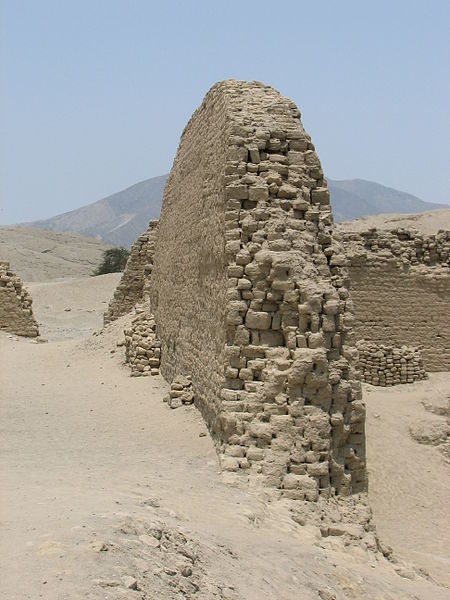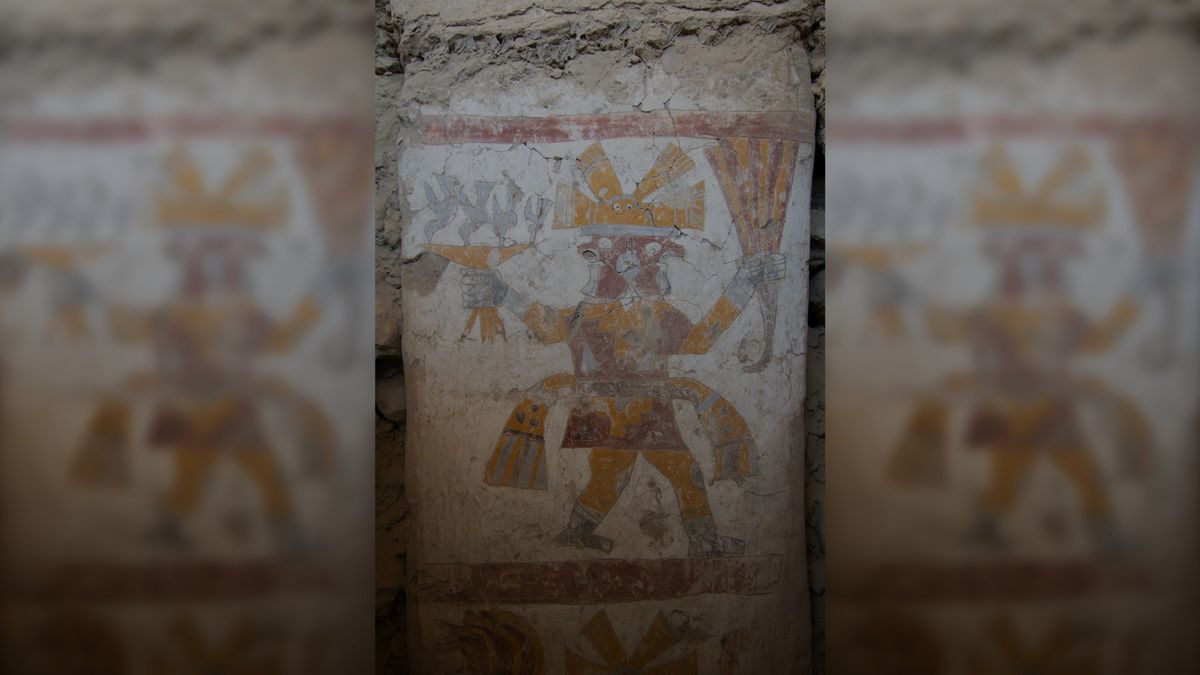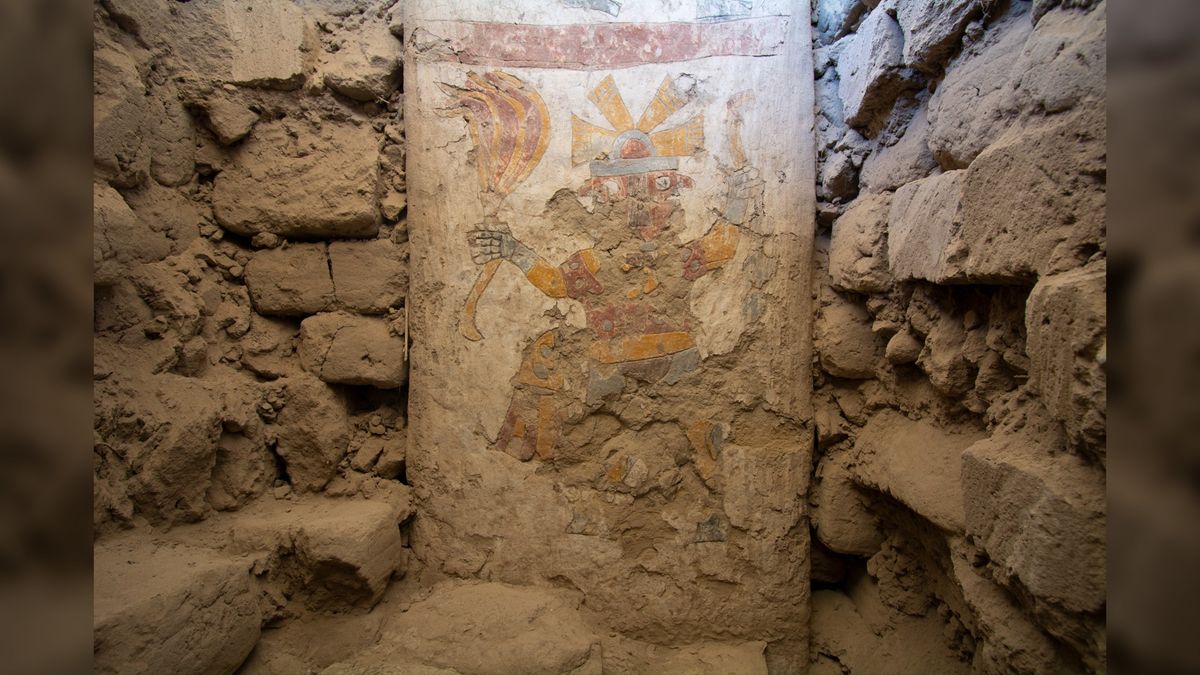Latin America
Related: About this forumANCIENT MURALS DEPICTING TWO-FACED FIGURES FOUND IN PERU
ARCHAEOLOGISTS FROM COLUMBIA UNIVERSITY AND THE DENVER MUSEUM OF NATURE & SCIENCE (DMNS) HAVE UNCOVERED A CEREMONIAL HALL ASSOCIATED WITH THE MOCHE CULTURE, CONTAINING 1,400-YEAR-OLD MURALS DEPICTING TWO-FACED FIGURES.
The Moche culture, also known as the Mochica culture, is an ancient Andean civilisation that flourished from the 1st to the 8th century AD on the northern coast of Peru. The name is taken from the great site of Moche, in the river valley of the same name, which appears to have been the capital or chief city of the Moche civilisation.
Excavations conducted at the archaeological site of , an architectural complex constructed between AD 550-800 in the Peruvian Ancash region’s lower Nepeña Valley, have revealed adobe walls decorated with 1,400-year-old murals.
Murals painted on a pillar depicts two-faced figures, one of which is shown holding a feather fan and a goblet with four hummingbirds, while the other figure is holding a feather fan and staff.
More:
https://www.heritagedaily.com/2023/03/ancient-murals-depicting-two-faced-figures-found-in-peru/146551
~ ~ ~
Wikipedia:
Pañamarca[1][2] (possibly from Quechua paña, "right hand, on the right", marka "village"[3][4]) is an archaeological site in the Ancash Region in Peru.[5] It is situated in the Santa Province, Nepeña District, on the right bank of the Nepeña River. An aspect of this archaeological site that is not well known is that this site is home to many artifacts that link back to the Incan Empire.[1] This site is also linked with the Moche culture[1] and together, this site was occupied by two civilizations, the Inca and the Moche, which is significant because the archaeology that is present at the site shows that the site was important in the eyes of multiple cultures.
While Pañamarka may at one time have once been quite aesthetically pleasing and grand, it is but a small collection of ruined walls, rock, and sand today. However, future excavations at the site may uncover more of the city buried beneath the Earth, and could perhaps provide archaeologists with enough information so that they might create an artistic reconstruction of what the city looked like during the height of its occupation.

Pañamarca and the Moche
Shields, war clubs, and weapon bundles
The Moche culture (100 AD – 700 AD) occupied the site of Pañamarca during the late period of the Moche, from 600 AD to the end of the Moche. During that period of acquisition the Moche left behind valuable artifacts that were a window into what the Moche were like. The artifacts they left behind were handmade shields woven with fibrous plants. These shields had a burlap-like material with decorations on the front facing side of the shield.[1] "The shield seems to have been left as an offering that preceded a renovation of the painted temple during the late Moche period (c.600–850 C.E.)."[1] Presumably these shields would have been used in religious and or militaristic ceremonies, yet this does not discount the concept that they were exclusively employed in displays of pageantry. Even in the most devastating of military campaigns the formalities of battlefield action, official dress and regalia, and the brandishing of national colors and symbols were ritualized. The shield implies that an object of its kind could transcend its defensive function and become an abstract symbol, potent within Moche ritual. Moche shields and war clubs were primary elements of the weapon bundle motif which was ubiquitous in Moche arts, especially during the Middle Moche (c. 400 C.E.) and beyond. The panoply was oft to also incorporate spear throwers, darts, and at times the garments of fallen warriors. By the Late Moche period, the weapon bundle became one of the most important symbols in Moche art. The club and shield motif was so important that it became a kind of logo for the Moche culture, and the trophy bundles of the defeated warriors' weapons and clothes became an "iconic, summarizing symbol" for the military focused Moche ideology. The discovery of the Moche feathered shield makes clear that, despite great loss from centuries of extensive looting, neglect, and environmental catastrophe, all has not been lost at Pañamarca.[1]

More:
https://en.wikipedia.org/wiki/Pa%C3%B1amarca
malaise
(268,846 posts)Thanks for this. ![]()
Judi Lynn
(160,508 posts)Thank you for taking the time to check them. ![]()
Judi Lynn
(160,508 posts)By Owen Jarus published about 20 hours ago
Archaeologists have discovered two 1,400-year-old murals of two-faced men within a ceremonial hall that belonged to the Moche culture of Peru.

One of the two-faced men is shown here. The goblet they hold at left has four hummingbirds drinking out of it and a rigid feather fan is held in the other hand. (Image credit: Lisa Trever)
Two murals of two-faced men holding unusual treasures — including a goblet that hummingbirds are drinking from, a detail that may allude to sacrifice and "cosmic realms" — were recently discovered at the 1,400-year-old archaeological site of Pañamarca in coastal Peru.
Both murals, which adorn the same pillar within a ceremonial hall, are rich in detail. In one mural, which sits near the top of the pillar, a man with two faces — one looking left and one looking right — holds a feather fan in one hand and a goblet with four hummingbirds drinking from it in the other. The second two-faced man, painted lower on the pillar, has a moving feather fan in one hand and a stick-like object that is only partly preserved in the other. Researchers say the artists may have been experimenting with how to depict movement.
Both men are wearing what looks like a headdress or crown on their heads and colorful clothing that has elaborate patterns and what appear to be sizable belts. The murals were unearthed by archaeologists in August 2022

The other two-faced man is shown here. They carry a feather fan that is moving. (Image credit: Lisa Trever)
Why the Moche depicted these two men like this is a mystery. "There is nothing quite like this in South American archaeology," Lisa Trever(opens in new tab), an associate professor of pre-Columbian art history and archaeology at Columbia University who is one of the leaders of the team, told Live Science in an email. "The artists may have been experimenting with how to show movement, and two narrative moments at once."
More:
https://www.livescience.com/1400-year-old-mural-of-2-faced-men-unearthed-in-peru-may-allude-to-cosmic-realms